Environmental Risk Assessment of Overcrowding in Australian Cities
VerifiedAdded on 2023/03/23
|14
|3672
|89
Report
AI Summary
This report provides an environmental risk assessment of overcrowding in Australia, focusing on the health impacts of this issue. The report identifies overcrowding as a significant public health concern, particularly in cities like Melbourne, where high living costs lead to reduced affordable housing options. It explores both resident-related risks, such as poor mental and physical health and increased infectious disease incidence, and property-related risks, including fire hazards. The report highlights the vulnerability of Indigenous Australians to overcrowding-related health problems and discusses specific infectious diseases like gastrointestinal infections, skin diseases, and respiratory illnesses. The assessment also addresses fire safety concerns in high-rise buildings and the role of migration in disease transmission. The report concludes with a discussion of risk characterization and the need for effective risk management strategies to mitigate the negative consequences of overcrowding. The report examines the issue of overcrowding, associated health problems, assessment of health risk from environmental hazards and an alternative risk management plan.
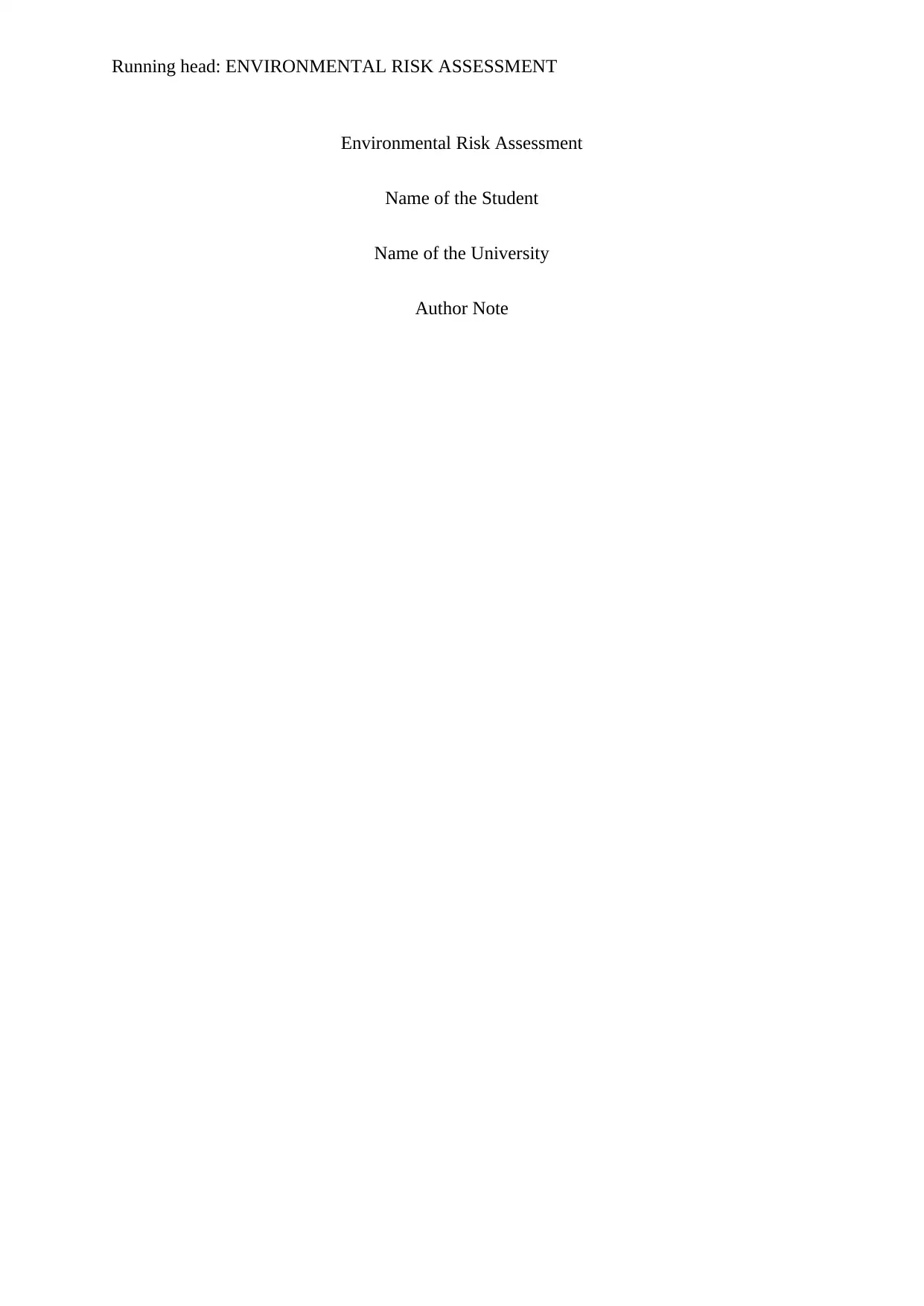
Running head: ENVIRONMENTAL RISK ASSESSMENT
Environmental Risk Assessment
Name of the Student
Name of the University
Author Note
Environmental Risk Assessment
Name of the Student
Name of the University
Author Note
Paraphrase This Document
Need a fresh take? Get an instant paraphrase of this document with our AI Paraphraser
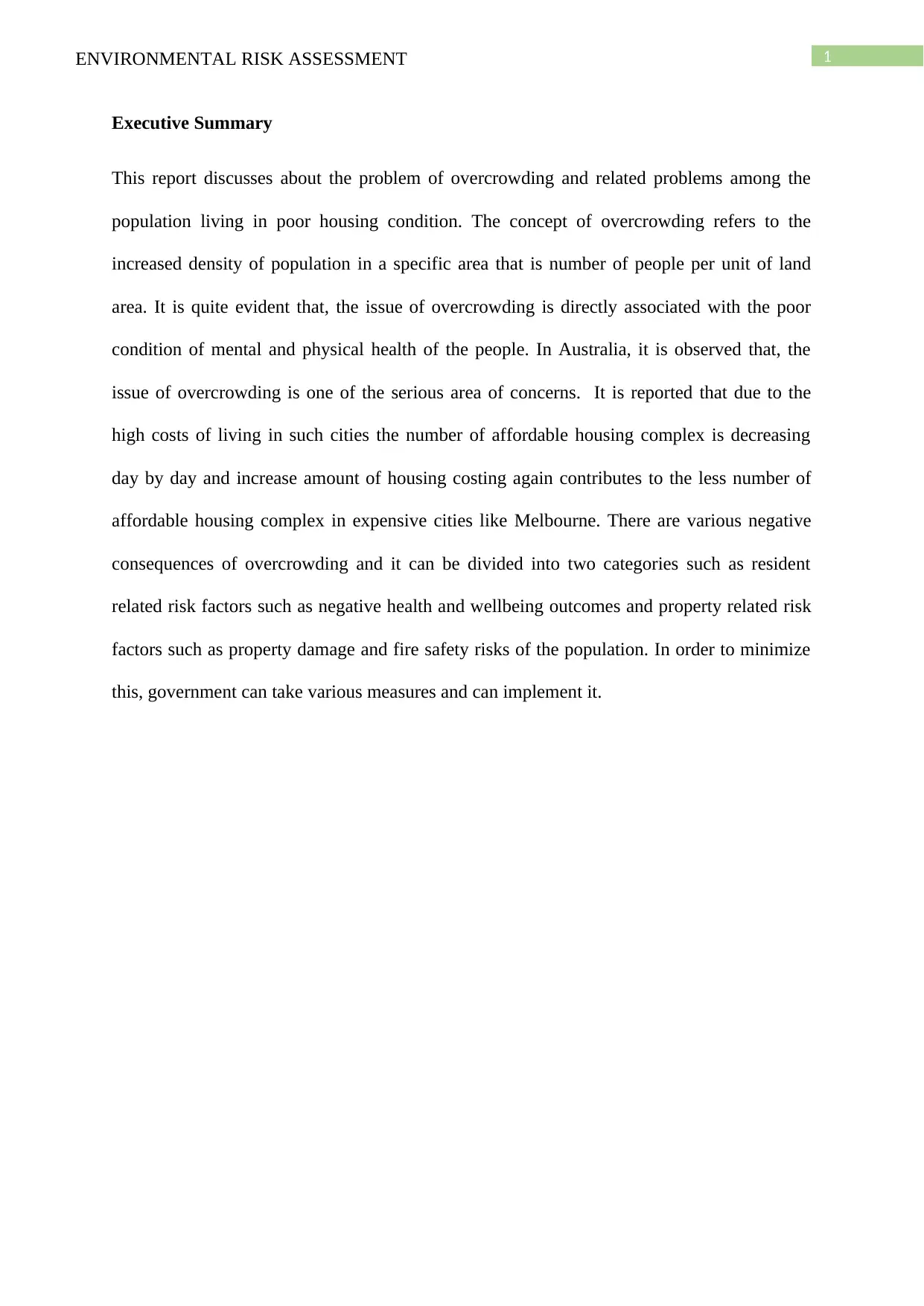
1ENVIRONMENTAL RISK ASSESSMENT
Executive Summary
This report discusses about the problem of overcrowding and related problems among the
population living in poor housing condition. The concept of overcrowding refers to the
increased density of population in a specific area that is number of people per unit of land
area. It is quite evident that, the issue of overcrowding is directly associated with the poor
condition of mental and physical health of the people. In Australia, it is observed that, the
issue of overcrowding is one of the serious area of concerns. It is reported that due to the
high costs of living in such cities the number of affordable housing complex is decreasing
day by day and increase amount of housing costing again contributes to the less number of
affordable housing complex in expensive cities like Melbourne. There are various negative
consequences of overcrowding and it can be divided into two categories such as resident
related risk factors such as negative health and wellbeing outcomes and property related risk
factors such as property damage and fire safety risks of the population. In order to minimize
this, government can take various measures and can implement it.
Executive Summary
This report discusses about the problem of overcrowding and related problems among the
population living in poor housing condition. The concept of overcrowding refers to the
increased density of population in a specific area that is number of people per unit of land
area. It is quite evident that, the issue of overcrowding is directly associated with the poor
condition of mental and physical health of the people. In Australia, it is observed that, the
issue of overcrowding is one of the serious area of concerns. It is reported that due to the
high costs of living in such cities the number of affordable housing complex is decreasing
day by day and increase amount of housing costing again contributes to the less number of
affordable housing complex in expensive cities like Melbourne. There are various negative
consequences of overcrowding and it can be divided into two categories such as resident
related risk factors such as negative health and wellbeing outcomes and property related risk
factors such as property damage and fire safety risks of the population. In order to minimize
this, government can take various measures and can implement it.
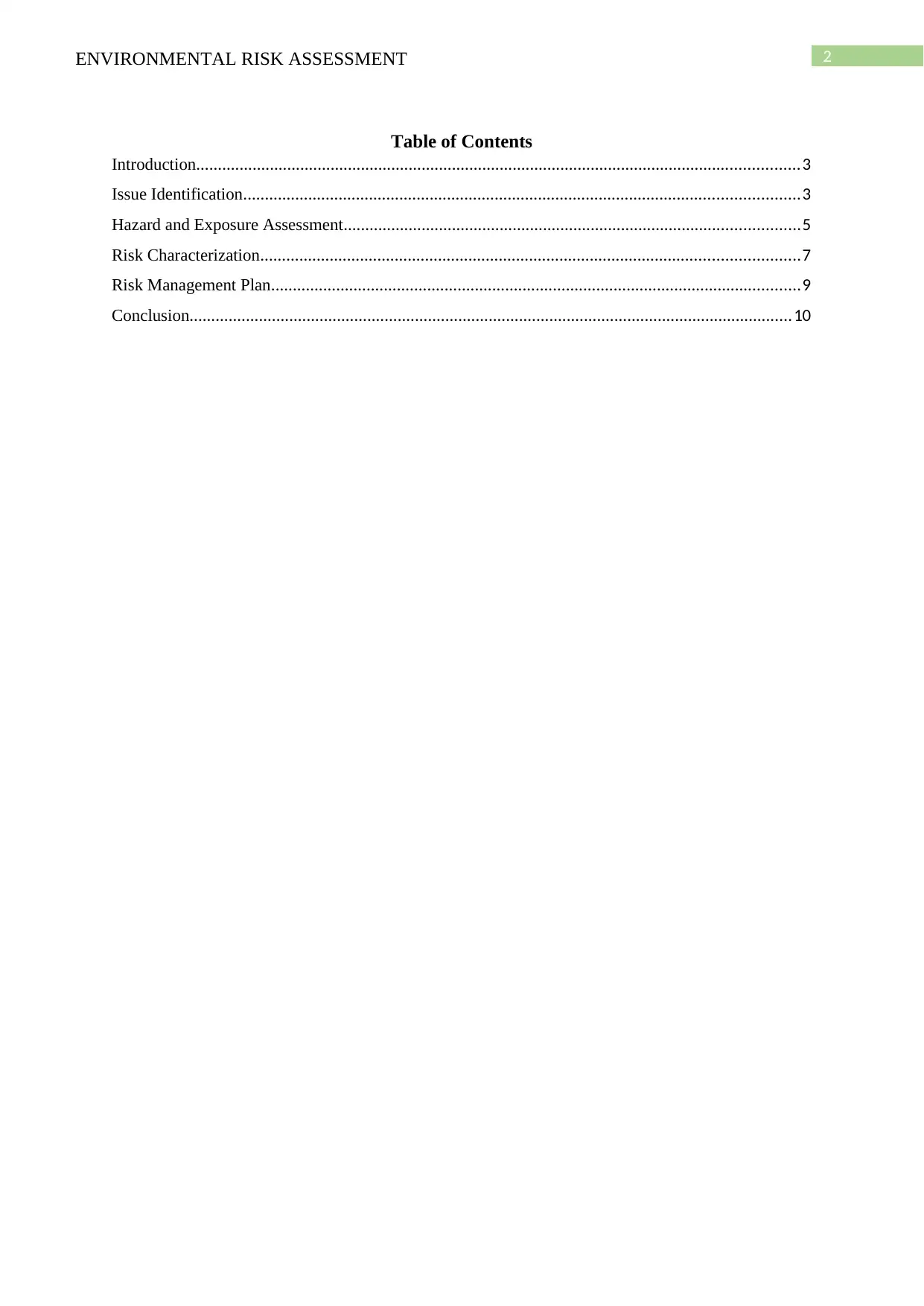
2ENVIRONMENTAL RISK ASSESSMENT
Table of Contents
Introduction...........................................................................................................................................3
Issue Identification................................................................................................................................3
Hazard and Exposure Assessment.........................................................................................................5
Risk Characterization............................................................................................................................7
Risk Management Plan..........................................................................................................................9
Conclusion...........................................................................................................................................10
Table of Contents
Introduction...........................................................................................................................................3
Issue Identification................................................................................................................................3
Hazard and Exposure Assessment.........................................................................................................5
Risk Characterization............................................................................................................................7
Risk Management Plan..........................................................................................................................9
Conclusion...........................................................................................................................................10
⊘ This is a preview!⊘
Do you want full access?
Subscribe today to unlock all pages.

Trusted by 1+ million students worldwide

3ENVIRONMENTAL RISK ASSESSMENT
Introduction
The concept of overcrowding refers to the increased density of population in a
specific area that is number of people per unit of land area. It is quite evident that, the issue of
overcrowding is directly associated with the poor condition of mental and physical health of
the people. In Australia, it is observed that, the issue of overcrowding is one of the serious
area of concerns. Australian capital cities are one of the most expensive cities in the world
and it is reported that due to the high costs of living in such cities the number of affordable
housing complex is decreasing day by day and increase amount of housing costing again
contributes to the less number of affordable housing complex in expensive cities like
Melbourne. Overcrowding occurs when, a dwelling area is not at all adequate to meet the
requirements of the households in terms of composition and numbers of the people living in
that area (Pawson & Herath, 2017). There are various negative consequences of
overcrowding and it can be divided into two categories such as resident related risk factors
such as negative health and wellbeing outcomes and property related risk factors such as
property damage and fire safety risks of the population. In addition, in recent years this issue
of overcrowding is mainly observed among the Indigenous Australians and the overcrowding
related health issues are also observed among the Indigenous Australians (Braveman &
Gottlieb, 2014). In this report, the issue of overcrowding, overcrowding related health
problems, assessment of the level of health risk from the identified environmental hazards
and an alternative risk management plan are discussed.
Issue Identification
In the residents of Australia, the health related hazards due to the issue of
overcrowding is quite common. Under the resident related risks of overcrowding in Australia
Introduction
The concept of overcrowding refers to the increased density of population in a
specific area that is number of people per unit of land area. It is quite evident that, the issue of
overcrowding is directly associated with the poor condition of mental and physical health of
the people. In Australia, it is observed that, the issue of overcrowding is one of the serious
area of concerns. Australian capital cities are one of the most expensive cities in the world
and it is reported that due to the high costs of living in such cities the number of affordable
housing complex is decreasing day by day and increase amount of housing costing again
contributes to the less number of affordable housing complex in expensive cities like
Melbourne. Overcrowding occurs when, a dwelling area is not at all adequate to meet the
requirements of the households in terms of composition and numbers of the people living in
that area (Pawson & Herath, 2017). There are various negative consequences of
overcrowding and it can be divided into two categories such as resident related risk factors
such as negative health and wellbeing outcomes and property related risk factors such as
property damage and fire safety risks of the population. In addition, in recent years this issue
of overcrowding is mainly observed among the Indigenous Australians and the overcrowding
related health issues are also observed among the Indigenous Australians (Braveman &
Gottlieb, 2014). In this report, the issue of overcrowding, overcrowding related health
problems, assessment of the level of health risk from the identified environmental hazards
and an alternative risk management plan are discussed.
Issue Identification
In the residents of Australia, the health related hazards due to the issue of
overcrowding is quite common. Under the resident related risks of overcrowding in Australia
Paraphrase This Document
Need a fresh take? Get an instant paraphrase of this document with our AI Paraphraser
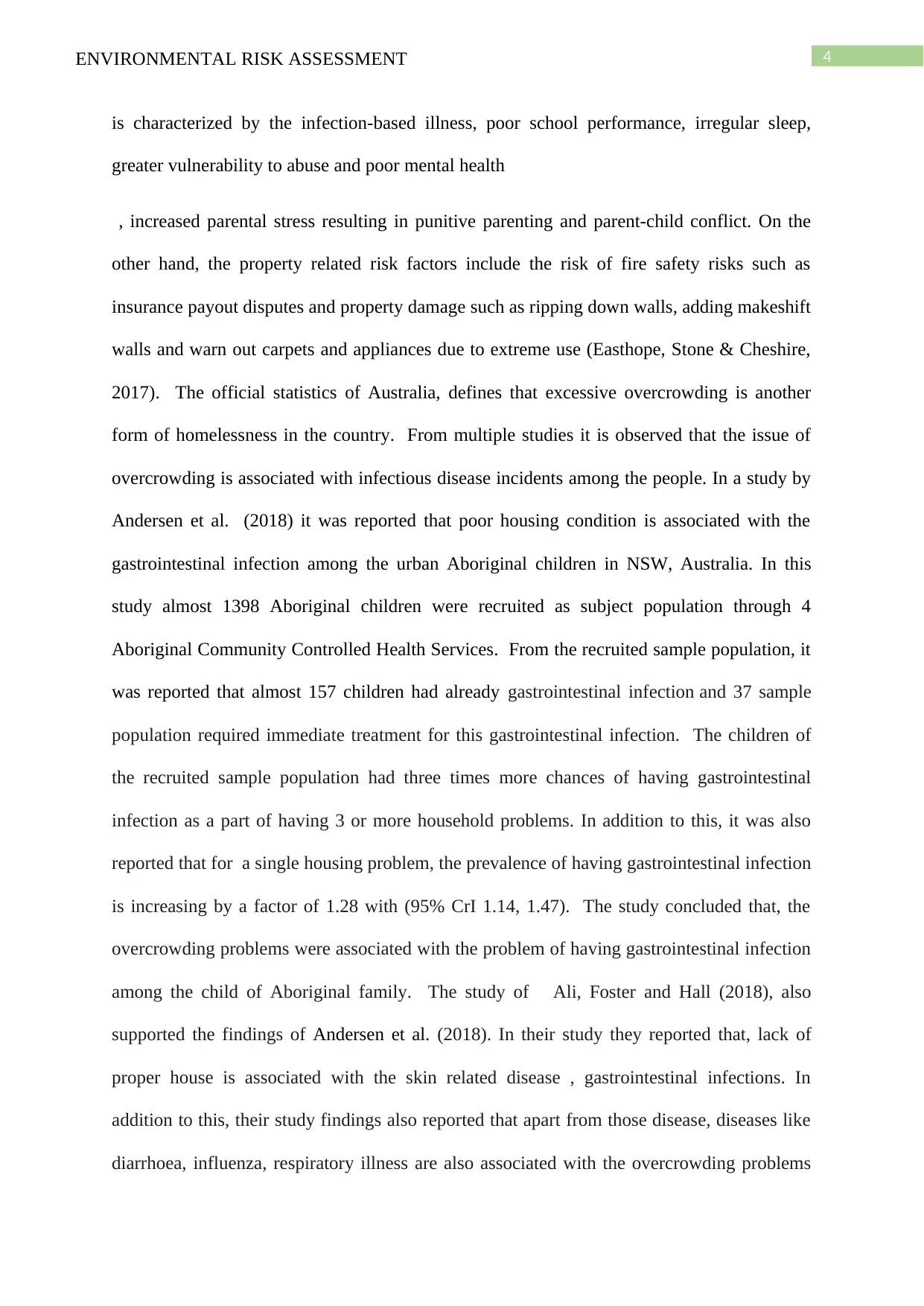
4ENVIRONMENTAL RISK ASSESSMENT
is characterized by the infection-based illness, poor school performance, irregular sleep,
greater vulnerability to abuse and poor mental health
, increased parental stress resulting in punitive parenting and parent-child conflict. On the
other hand, the property related risk factors include the risk of fire safety risks such as
insurance payout disputes and property damage such as ripping down walls, adding makeshift
walls and warn out carpets and appliances due to extreme use (Easthope, Stone & Cheshire,
2017). The official statistics of Australia, defines that excessive overcrowding is another
form of homelessness in the country. From multiple studies it is observed that the issue of
overcrowding is associated with infectious disease incidents among the people. In a study by
Andersen et al. (2018) it was reported that poor housing condition is associated with the
gastrointestinal infection among the urban Aboriginal children in NSW, Australia. In this
study almost 1398 Aboriginal children were recruited as subject population through 4
Aboriginal Community Controlled Health Services. From the recruited sample population, it
was reported that almost 157 children had already gastrointestinal infection and 37 sample
population required immediate treatment for this gastrointestinal infection. The children of
the recruited sample population had three times more chances of having gastrointestinal
infection as a part of having 3 or more household problems. In addition to this, it was also
reported that for a single housing problem, the prevalence of having gastrointestinal infection
is increasing by a factor of 1.28 with (95% CrI 1.14, 1.47). The study concluded that, the
overcrowding problems were associated with the problem of having gastrointestinal infection
among the child of Aboriginal family. The study of Ali, Foster and Hall (2018), also
supported the findings of Andersen et al. (2018). In their study they reported that, lack of
proper house is associated with the skin related disease , gastrointestinal infections. In
addition to this, their study findings also reported that apart from those disease, diseases like
diarrhoea, influenza, respiratory illness are also associated with the overcrowding problems
is characterized by the infection-based illness, poor school performance, irregular sleep,
greater vulnerability to abuse and poor mental health
, increased parental stress resulting in punitive parenting and parent-child conflict. On the
other hand, the property related risk factors include the risk of fire safety risks such as
insurance payout disputes and property damage such as ripping down walls, adding makeshift
walls and warn out carpets and appliances due to extreme use (Easthope, Stone & Cheshire,
2017). The official statistics of Australia, defines that excessive overcrowding is another
form of homelessness in the country. From multiple studies it is observed that the issue of
overcrowding is associated with infectious disease incidents among the people. In a study by
Andersen et al. (2018) it was reported that poor housing condition is associated with the
gastrointestinal infection among the urban Aboriginal children in NSW, Australia. In this
study almost 1398 Aboriginal children were recruited as subject population through 4
Aboriginal Community Controlled Health Services. From the recruited sample population, it
was reported that almost 157 children had already gastrointestinal infection and 37 sample
population required immediate treatment for this gastrointestinal infection. The children of
the recruited sample population had three times more chances of having gastrointestinal
infection as a part of having 3 or more household problems. In addition to this, it was also
reported that for a single housing problem, the prevalence of having gastrointestinal infection
is increasing by a factor of 1.28 with (95% CrI 1.14, 1.47). The study concluded that, the
overcrowding problems were associated with the problem of having gastrointestinal infection
among the child of Aboriginal family. The study of Ali, Foster and Hall (2018), also
supported the findings of Andersen et al. (2018). In their study they reported that, lack of
proper house is associated with the skin related disease , gastrointestinal infections. In
addition to this, their study findings also reported that apart from those disease, diseases like
diarrhoea, influenza, respiratory illness are also associated with the overcrowding problems
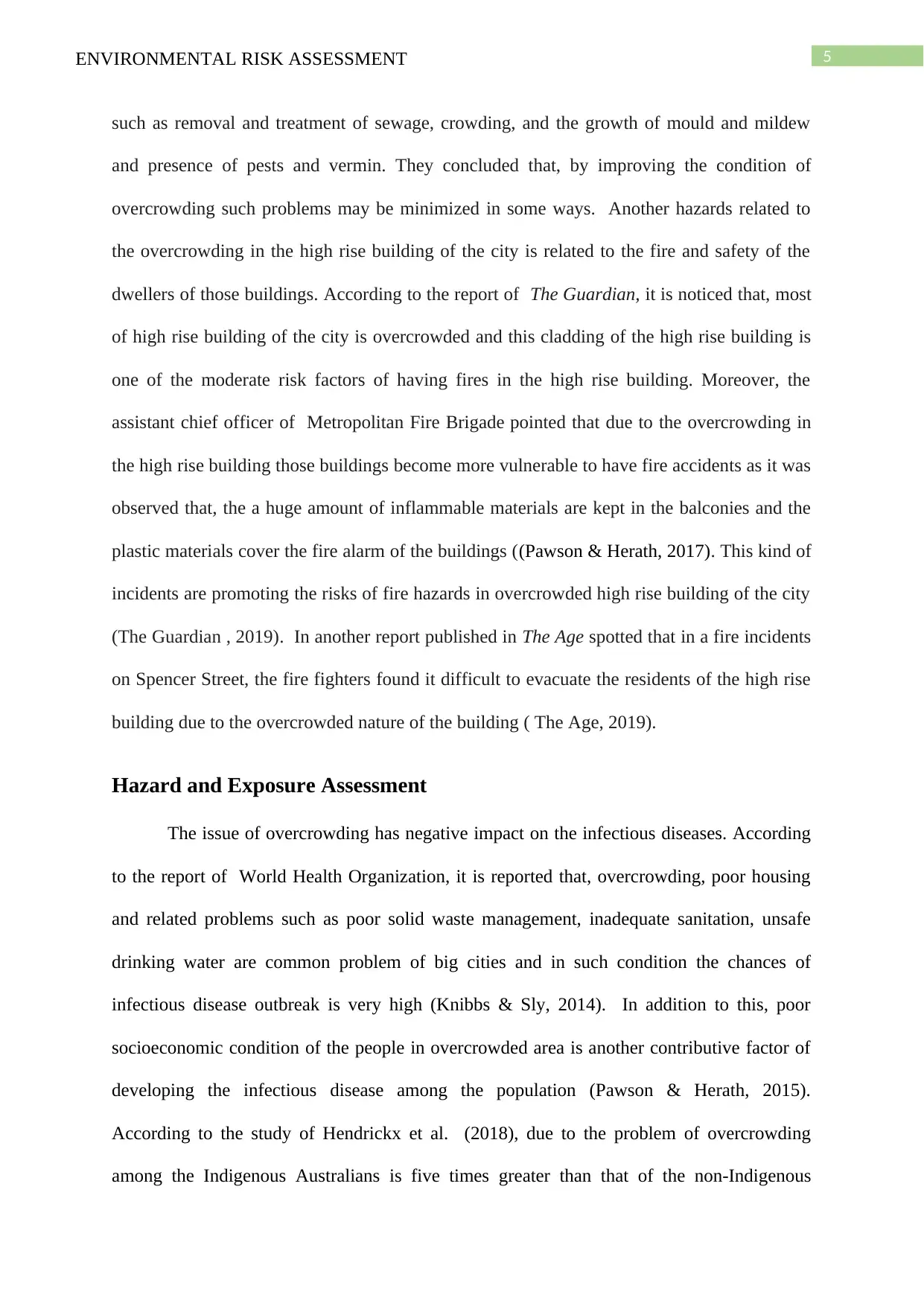
5ENVIRONMENTAL RISK ASSESSMENT
such as removal and treatment of sewage, crowding, and the growth of mould and mildew
and presence of pests and vermin. They concluded that, by improving the condition of
overcrowding such problems may be minimized in some ways. Another hazards related to
the overcrowding in the high rise building of the city is related to the fire and safety of the
dwellers of those buildings. According to the report of The Guardian, it is noticed that, most
of high rise building of the city is overcrowded and this cladding of the high rise building is
one of the moderate risk factors of having fires in the high rise building. Moreover, the
assistant chief officer of Metropolitan Fire Brigade pointed that due to the overcrowding in
the high rise building those buildings become more vulnerable to have fire accidents as it was
observed that, the a huge amount of inflammable materials are kept in the balconies and the
plastic materials cover the fire alarm of the buildings ((Pawson & Herath, 2017). This kind of
incidents are promoting the risks of fire hazards in overcrowded high rise building of the city
(The Guardian , 2019). In another report published in The Age spotted that in a fire incidents
on Spencer Street, the fire fighters found it difficult to evacuate the residents of the high rise
building due to the overcrowded nature of the building ( The Age, 2019).
Hazard and Exposure Assessment
The issue of overcrowding has negative impact on the infectious diseases. According
to the report of World Health Organization, it is reported that, overcrowding, poor housing
and related problems such as poor solid waste management, inadequate sanitation, unsafe
drinking water are common problem of big cities and in such condition the chances of
infectious disease outbreak is very high (Knibbs & Sly, 2014). In addition to this, poor
socioeconomic condition of the people in overcrowded area is another contributive factor of
developing the infectious disease among the population (Pawson & Herath, 2015).
According to the study of Hendrickx et al. (2018), due to the problem of overcrowding
among the Indigenous Australians is five times greater than that of the non-Indigenous
such as removal and treatment of sewage, crowding, and the growth of mould and mildew
and presence of pests and vermin. They concluded that, by improving the condition of
overcrowding such problems may be minimized in some ways. Another hazards related to
the overcrowding in the high rise building of the city is related to the fire and safety of the
dwellers of those buildings. According to the report of The Guardian, it is noticed that, most
of high rise building of the city is overcrowded and this cladding of the high rise building is
one of the moderate risk factors of having fires in the high rise building. Moreover, the
assistant chief officer of Metropolitan Fire Brigade pointed that due to the overcrowding in
the high rise building those buildings become more vulnerable to have fire accidents as it was
observed that, the a huge amount of inflammable materials are kept in the balconies and the
plastic materials cover the fire alarm of the buildings ((Pawson & Herath, 2017). This kind of
incidents are promoting the risks of fire hazards in overcrowded high rise building of the city
(The Guardian , 2019). In another report published in The Age spotted that in a fire incidents
on Spencer Street, the fire fighters found it difficult to evacuate the residents of the high rise
building due to the overcrowded nature of the building ( The Age, 2019).
Hazard and Exposure Assessment
The issue of overcrowding has negative impact on the infectious diseases. According
to the report of World Health Organization, it is reported that, overcrowding, poor housing
and related problems such as poor solid waste management, inadequate sanitation, unsafe
drinking water are common problem of big cities and in such condition the chances of
infectious disease outbreak is very high (Knibbs & Sly, 2014). In addition to this, poor
socioeconomic condition of the people in overcrowded area is another contributive factor of
developing the infectious disease among the population (Pawson & Herath, 2015).
According to the study of Hendrickx et al. (2018), due to the problem of overcrowding
among the Indigenous Australians is five times greater than that of the non-Indigenous
⊘ This is a preview!⊘
Do you want full access?
Subscribe today to unlock all pages.

Trusted by 1+ million students worldwide
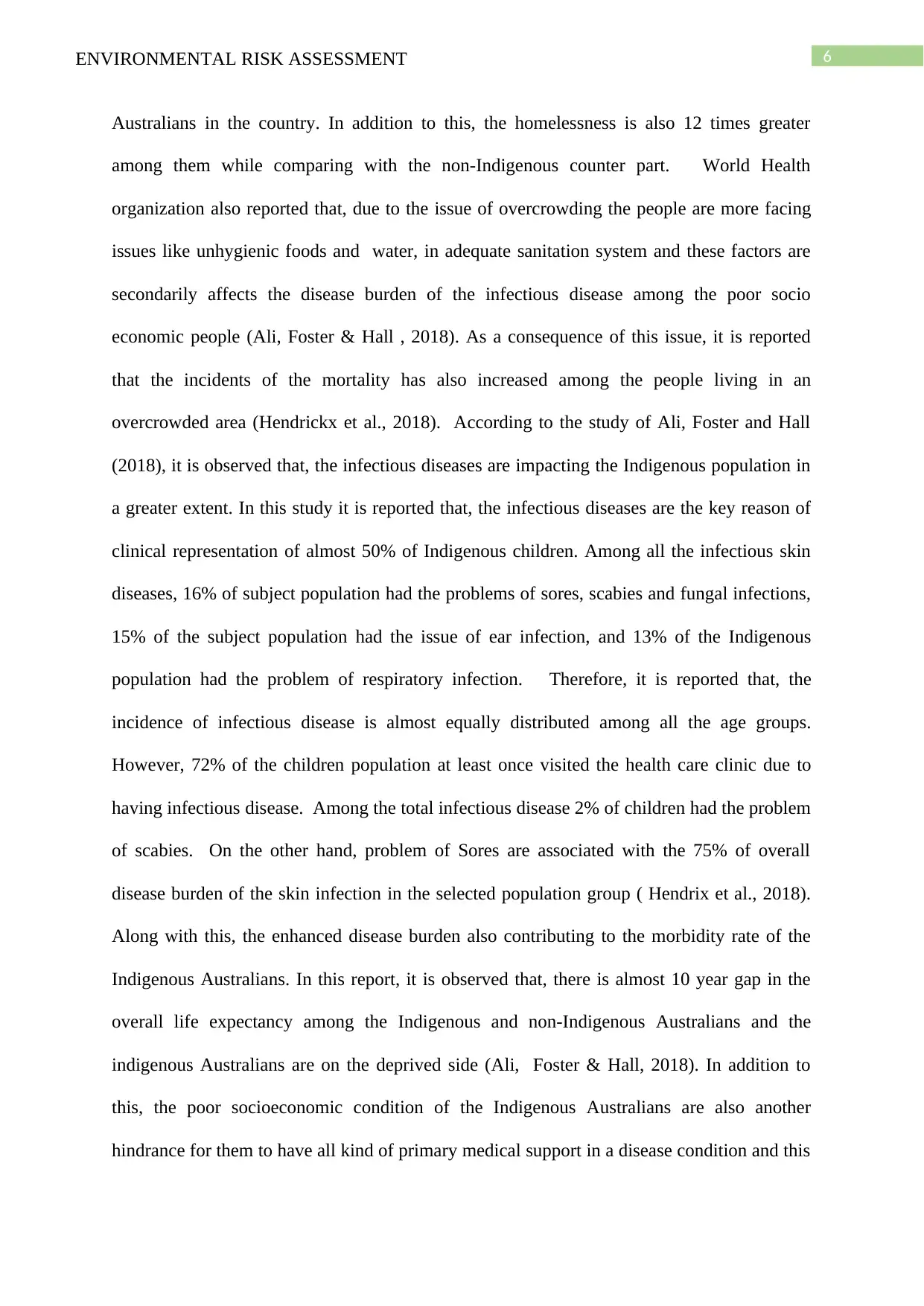
6ENVIRONMENTAL RISK ASSESSMENT
Australians in the country. In addition to this, the homelessness is also 12 times greater
among them while comparing with the non-Indigenous counter part. World Health
organization also reported that, due to the issue of overcrowding the people are more facing
issues like unhygienic foods and water, in adequate sanitation system and these factors are
secondarily affects the disease burden of the infectious disease among the poor socio
economic people (Ali, Foster & Hall , 2018). As a consequence of this issue, it is reported
that the incidents of the mortality has also increased among the people living in an
overcrowded area (Hendrickx et al., 2018). According to the study of Ali, Foster and Hall
(2018), it is observed that, the infectious diseases are impacting the Indigenous population in
a greater extent. In this study it is reported that, the infectious diseases are the key reason of
clinical representation of almost 50% of Indigenous children. Among all the infectious skin
diseases, 16% of subject population had the problems of sores, scabies and fungal infections,
15% of the subject population had the issue of ear infection, and 13% of the Indigenous
population had the problem of respiratory infection. Therefore, it is reported that, the
incidence of infectious disease is almost equally distributed among all the age groups.
However, 72% of the children population at least once visited the health care clinic due to
having infectious disease. Among the total infectious disease 2% of children had the problem
of scabies. On the other hand, problem of Sores are associated with the 75% of overall
disease burden of the skin infection in the selected population group ( Hendrix et al., 2018).
Along with this, the enhanced disease burden also contributing to the morbidity rate of the
Indigenous Australians. In this report, it is observed that, there is almost 10 year gap in the
overall life expectancy among the Indigenous and non-Indigenous Australians and the
indigenous Australians are on the deprived side (Ali, Foster & Hall, 2018). In addition to
this, the poor socioeconomic condition of the Indigenous Australians are also another
hindrance for them to have all kind of primary medical support in a disease condition and this
Australians in the country. In addition to this, the homelessness is also 12 times greater
among them while comparing with the non-Indigenous counter part. World Health
organization also reported that, due to the issue of overcrowding the people are more facing
issues like unhygienic foods and water, in adequate sanitation system and these factors are
secondarily affects the disease burden of the infectious disease among the poor socio
economic people (Ali, Foster & Hall , 2018). As a consequence of this issue, it is reported
that the incidents of the mortality has also increased among the people living in an
overcrowded area (Hendrickx et al., 2018). According to the study of Ali, Foster and Hall
(2018), it is observed that, the infectious diseases are impacting the Indigenous population in
a greater extent. In this study it is reported that, the infectious diseases are the key reason of
clinical representation of almost 50% of Indigenous children. Among all the infectious skin
diseases, 16% of subject population had the problems of sores, scabies and fungal infections,
15% of the subject population had the issue of ear infection, and 13% of the Indigenous
population had the problem of respiratory infection. Therefore, it is reported that, the
incidence of infectious disease is almost equally distributed among all the age groups.
However, 72% of the children population at least once visited the health care clinic due to
having infectious disease. Among the total infectious disease 2% of children had the problem
of scabies. On the other hand, problem of Sores are associated with the 75% of overall
disease burden of the skin infection in the selected population group ( Hendrix et al., 2018).
Along with this, the enhanced disease burden also contributing to the morbidity rate of the
Indigenous Australians. In this report, it is observed that, there is almost 10 year gap in the
overall life expectancy among the Indigenous and non-Indigenous Australians and the
indigenous Australians are on the deprived side (Ali, Foster & Hall, 2018). In addition to
this, the poor socioeconomic condition of the Indigenous Australians are also another
hindrance for them to have all kind of primary medical support in a disease condition and this
Paraphrase This Document
Need a fresh take? Get an instant paraphrase of this document with our AI Paraphraser
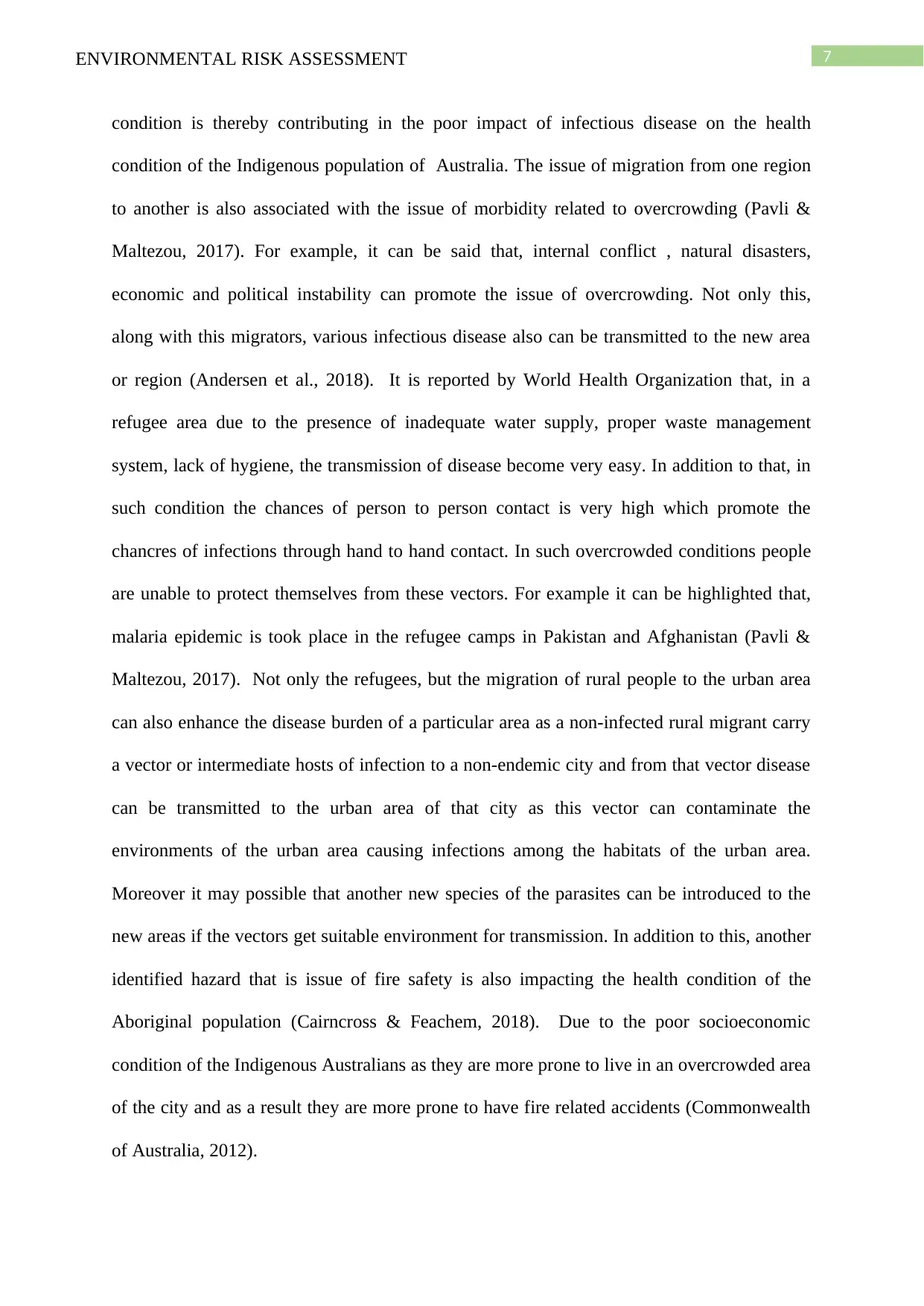
7ENVIRONMENTAL RISK ASSESSMENT
condition is thereby contributing in the poor impact of infectious disease on the health
condition of the Indigenous population of Australia. The issue of migration from one region
to another is also associated with the issue of morbidity related to overcrowding (Pavli &
Maltezou, 2017). For example, it can be said that, internal conflict , natural disasters,
economic and political instability can promote the issue of overcrowding. Not only this,
along with this migrators, various infectious disease also can be transmitted to the new area
or region (Andersen et al., 2018). It is reported by World Health Organization that, in a
refugee area due to the presence of inadequate water supply, proper waste management
system, lack of hygiene, the transmission of disease become very easy. In addition to that, in
such condition the chances of person to person contact is very high which promote the
chancres of infections through hand to hand contact. In such overcrowded conditions people
are unable to protect themselves from these vectors. For example it can be highlighted that,
malaria epidemic is took place in the refugee camps in Pakistan and Afghanistan (Pavli &
Maltezou, 2017). Not only the refugees, but the migration of rural people to the urban area
can also enhance the disease burden of a particular area as a non-infected rural migrant carry
a vector or intermediate hosts of infection to a non-endemic city and from that vector disease
can be transmitted to the urban area of that city as this vector can contaminate the
environments of the urban area causing infections among the habitats of the urban area.
Moreover it may possible that another new species of the parasites can be introduced to the
new areas if the vectors get suitable environment for transmission. In addition to this, another
identified hazard that is issue of fire safety is also impacting the health condition of the
Aboriginal population (Cairncross & Feachem, 2018). Due to the poor socioeconomic
condition of the Indigenous Australians as they are more prone to live in an overcrowded area
of the city and as a result they are more prone to have fire related accidents (Commonwealth
of Australia, 2012).
condition is thereby contributing in the poor impact of infectious disease on the health
condition of the Indigenous population of Australia. The issue of migration from one region
to another is also associated with the issue of morbidity related to overcrowding (Pavli &
Maltezou, 2017). For example, it can be said that, internal conflict , natural disasters,
economic and political instability can promote the issue of overcrowding. Not only this,
along with this migrators, various infectious disease also can be transmitted to the new area
or region (Andersen et al., 2018). It is reported by World Health Organization that, in a
refugee area due to the presence of inadequate water supply, proper waste management
system, lack of hygiene, the transmission of disease become very easy. In addition to that, in
such condition the chances of person to person contact is very high which promote the
chancres of infections through hand to hand contact. In such overcrowded conditions people
are unable to protect themselves from these vectors. For example it can be highlighted that,
malaria epidemic is took place in the refugee camps in Pakistan and Afghanistan (Pavli &
Maltezou, 2017). Not only the refugees, but the migration of rural people to the urban area
can also enhance the disease burden of a particular area as a non-infected rural migrant carry
a vector or intermediate hosts of infection to a non-endemic city and from that vector disease
can be transmitted to the urban area of that city as this vector can contaminate the
environments of the urban area causing infections among the habitats of the urban area.
Moreover it may possible that another new species of the parasites can be introduced to the
new areas if the vectors get suitable environment for transmission. In addition to this, another
identified hazard that is issue of fire safety is also impacting the health condition of the
Aboriginal population (Cairncross & Feachem, 2018). Due to the poor socioeconomic
condition of the Indigenous Australians as they are more prone to live in an overcrowded area
of the city and as a result they are more prone to have fire related accidents (Commonwealth
of Australia, 2012).
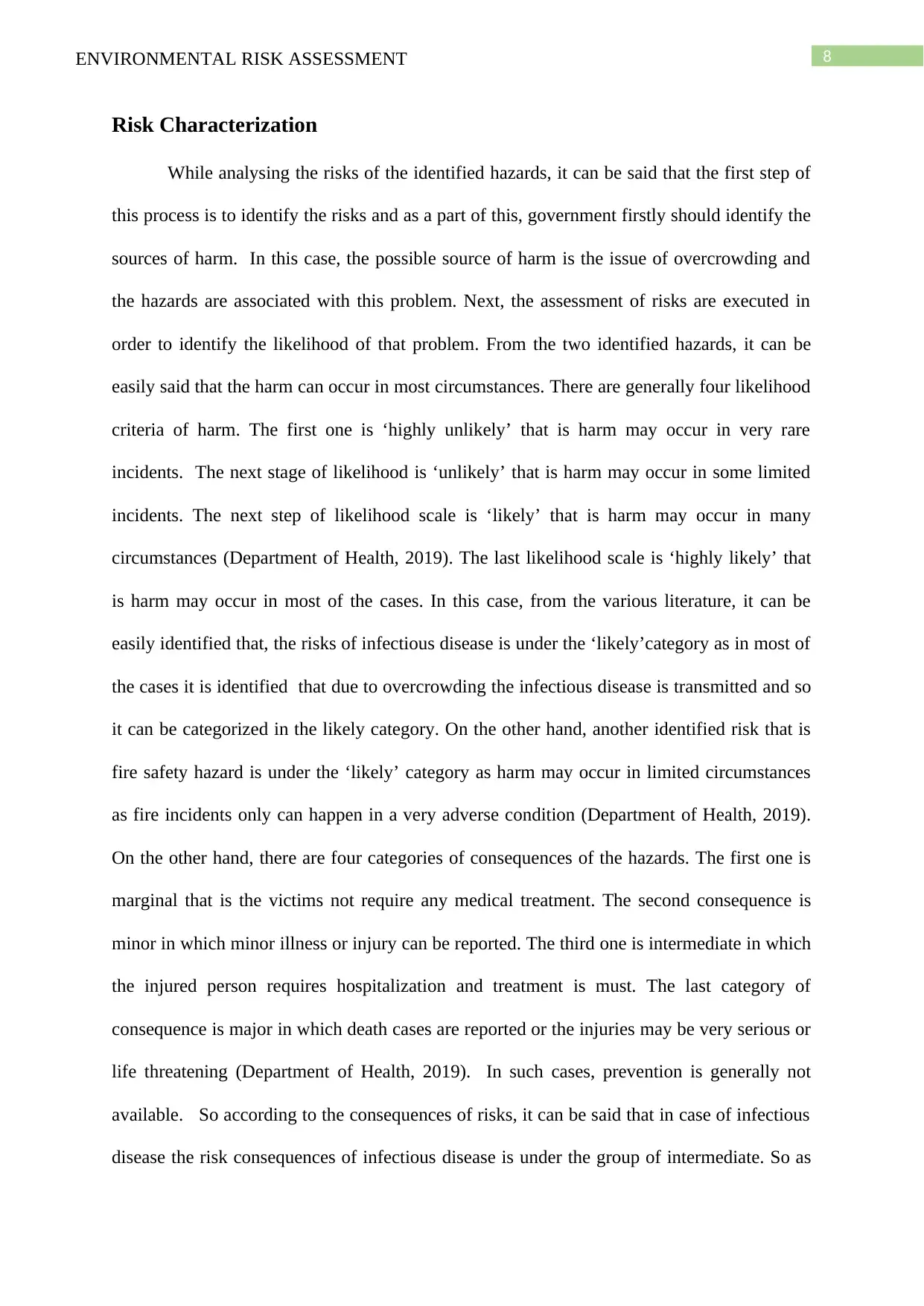
8ENVIRONMENTAL RISK ASSESSMENT
Risk Characterization
While analysing the risks of the identified hazards, it can be said that the first step of
this process is to identify the risks and as a part of this, government firstly should identify the
sources of harm. In this case, the possible source of harm is the issue of overcrowding and
the hazards are associated with this problem. Next, the assessment of risks are executed in
order to identify the likelihood of that problem. From the two identified hazards, it can be
easily said that the harm can occur in most circumstances. There are generally four likelihood
criteria of harm. The first one is ‘highly unlikely’ that is harm may occur in very rare
incidents. The next stage of likelihood is ‘unlikely’ that is harm may occur in some limited
incidents. The next step of likelihood scale is ‘likely’ that is harm may occur in many
circumstances (Department of Health, 2019). The last likelihood scale is ‘highly likely’ that
is harm may occur in most of the cases. In this case, from the various literature, it can be
easily identified that, the risks of infectious disease is under the ‘likely’category as in most of
the cases it is identified that due to overcrowding the infectious disease is transmitted and so
it can be categorized in the likely category. On the other hand, another identified risk that is
fire safety hazard is under the ‘likely’ category as harm may occur in limited circumstances
as fire incidents only can happen in a very adverse condition (Department of Health, 2019).
On the other hand, there are four categories of consequences of the hazards. The first one is
marginal that is the victims not require any medical treatment. The second consequence is
minor in which minor illness or injury can be reported. The third one is intermediate in which
the injured person requires hospitalization and treatment is must. The last category of
consequence is major in which death cases are reported or the injuries may be very serious or
life threatening (Department of Health, 2019). In such cases, prevention is generally not
available. So according to the consequences of risks, it can be said that in case of infectious
disease the risk consequences of infectious disease is under the group of intermediate. So as
Risk Characterization
While analysing the risks of the identified hazards, it can be said that the first step of
this process is to identify the risks and as a part of this, government firstly should identify the
sources of harm. In this case, the possible source of harm is the issue of overcrowding and
the hazards are associated with this problem. Next, the assessment of risks are executed in
order to identify the likelihood of that problem. From the two identified hazards, it can be
easily said that the harm can occur in most circumstances. There are generally four likelihood
criteria of harm. The first one is ‘highly unlikely’ that is harm may occur in very rare
incidents. The next stage of likelihood is ‘unlikely’ that is harm may occur in some limited
incidents. The next step of likelihood scale is ‘likely’ that is harm may occur in many
circumstances (Department of Health, 2019). The last likelihood scale is ‘highly likely’ that
is harm may occur in most of the cases. In this case, from the various literature, it can be
easily identified that, the risks of infectious disease is under the ‘likely’category as in most of
the cases it is identified that due to overcrowding the infectious disease is transmitted and so
it can be categorized in the likely category. On the other hand, another identified risk that is
fire safety hazard is under the ‘likely’ category as harm may occur in limited circumstances
as fire incidents only can happen in a very adverse condition (Department of Health, 2019).
On the other hand, there are four categories of consequences of the hazards. The first one is
marginal that is the victims not require any medical treatment. The second consequence is
minor in which minor illness or injury can be reported. The third one is intermediate in which
the injured person requires hospitalization and treatment is must. The last category of
consequence is major in which death cases are reported or the injuries may be very serious or
life threatening (Department of Health, 2019). In such cases, prevention is generally not
available. So according to the consequences of risks, it can be said that in case of infectious
disease the risk consequences of infectious disease is under the group of intermediate. So as
⊘ This is a preview!⊘
Do you want full access?
Subscribe today to unlock all pages.

Trusted by 1+ million students worldwide
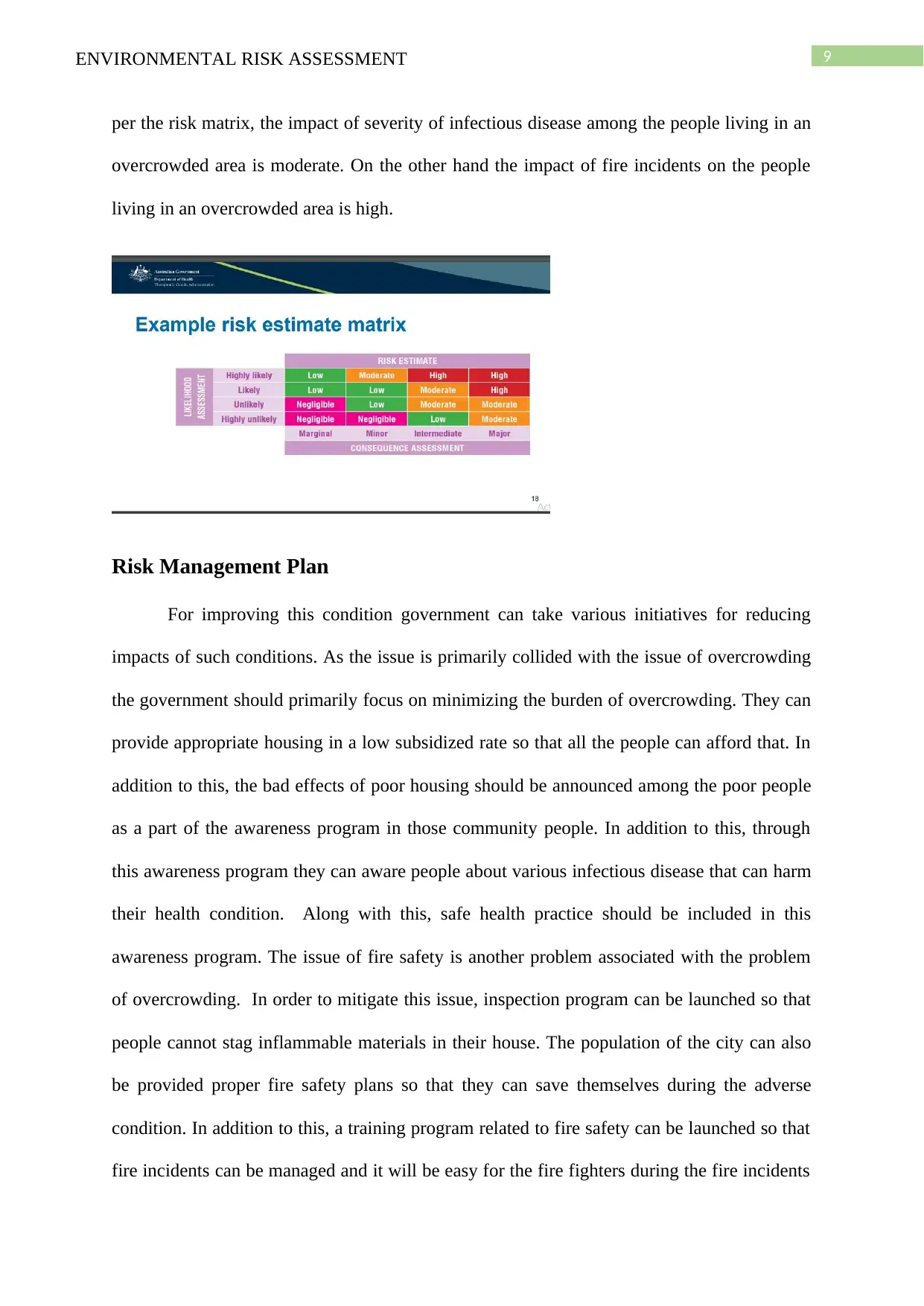
9ENVIRONMENTAL RISK ASSESSMENT
per the risk matrix, the impact of severity of infectious disease among the people living in an
overcrowded area is moderate. On the other hand the impact of fire incidents on the people
living in an overcrowded area is high.
Risk Management Plan
For improving this condition government can take various initiatives for reducing
impacts of such conditions. As the issue is primarily collided with the issue of overcrowding
the government should primarily focus on minimizing the burden of overcrowding. They can
provide appropriate housing in a low subsidized rate so that all the people can afford that. In
addition to this, the bad effects of poor housing should be announced among the poor people
as a part of the awareness program in those community people. In addition to this, through
this awareness program they can aware people about various infectious disease that can harm
their health condition. Along with this, safe health practice should be included in this
awareness program. The issue of fire safety is another problem associated with the problem
of overcrowding. In order to mitigate this issue, inspection program can be launched so that
people cannot stag inflammable materials in their house. The population of the city can also
be provided proper fire safety plans so that they can save themselves during the adverse
condition. In addition to this, a training program related to fire safety can be launched so that
fire incidents can be managed and it will be easy for the fire fighters during the fire incidents
per the risk matrix, the impact of severity of infectious disease among the people living in an
overcrowded area is moderate. On the other hand the impact of fire incidents on the people
living in an overcrowded area is high.
Risk Management Plan
For improving this condition government can take various initiatives for reducing
impacts of such conditions. As the issue is primarily collided with the issue of overcrowding
the government should primarily focus on minimizing the burden of overcrowding. They can
provide appropriate housing in a low subsidized rate so that all the people can afford that. In
addition to this, the bad effects of poor housing should be announced among the poor people
as a part of the awareness program in those community people. In addition to this, through
this awareness program they can aware people about various infectious disease that can harm
their health condition. Along with this, safe health practice should be included in this
awareness program. The issue of fire safety is another problem associated with the problem
of overcrowding. In order to mitigate this issue, inspection program can be launched so that
people cannot stag inflammable materials in their house. The population of the city can also
be provided proper fire safety plans so that they can save themselves during the adverse
condition. In addition to this, a training program related to fire safety can be launched so that
fire incidents can be managed and it will be easy for the fire fighters during the fire incidents
Paraphrase This Document
Need a fresh take? Get an instant paraphrase of this document with our AI Paraphraser
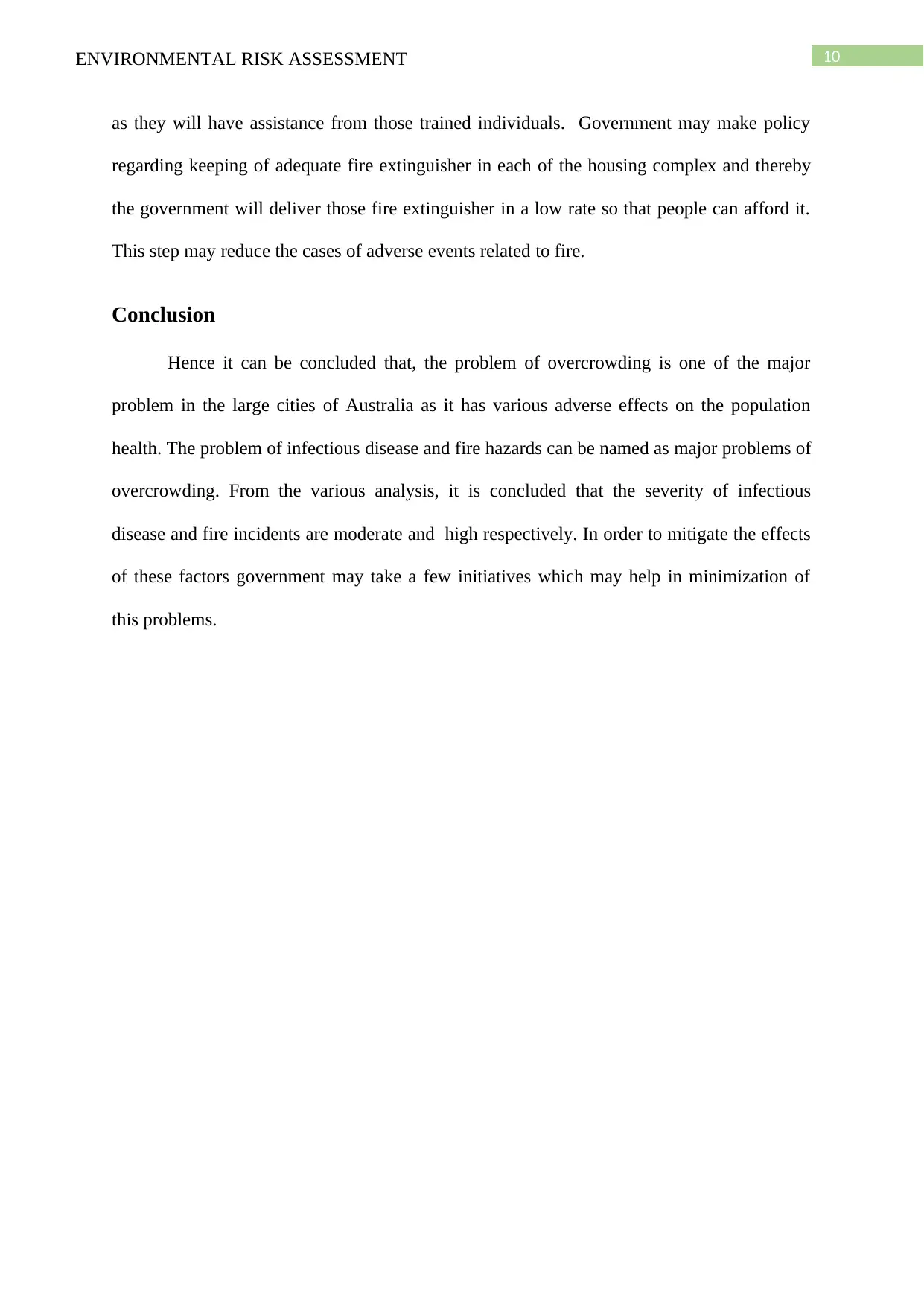
10ENVIRONMENTAL RISK ASSESSMENT
as they will have assistance from those trained individuals. Government may make policy
regarding keeping of adequate fire extinguisher in each of the housing complex and thereby
the government will deliver those fire extinguisher in a low rate so that people can afford it.
This step may reduce the cases of adverse events related to fire.
Conclusion
Hence it can be concluded that, the problem of overcrowding is one of the major
problem in the large cities of Australia as it has various adverse effects on the population
health. The problem of infectious disease and fire hazards can be named as major problems of
overcrowding. From the various analysis, it is concluded that the severity of infectious
disease and fire incidents are moderate and high respectively. In order to mitigate the effects
of these factors government may take a few initiatives which may help in minimization of
this problems.
as they will have assistance from those trained individuals. Government may make policy
regarding keeping of adequate fire extinguisher in each of the housing complex and thereby
the government will deliver those fire extinguisher in a low rate so that people can afford it.
This step may reduce the cases of adverse events related to fire.
Conclusion
Hence it can be concluded that, the problem of overcrowding is one of the major
problem in the large cities of Australia as it has various adverse effects on the population
health. The problem of infectious disease and fire hazards can be named as major problems of
overcrowding. From the various analysis, it is concluded that the severity of infectious
disease and fire incidents are moderate and high respectively. In order to mitigate the effects
of these factors government may take a few initiatives which may help in minimization of
this problems.
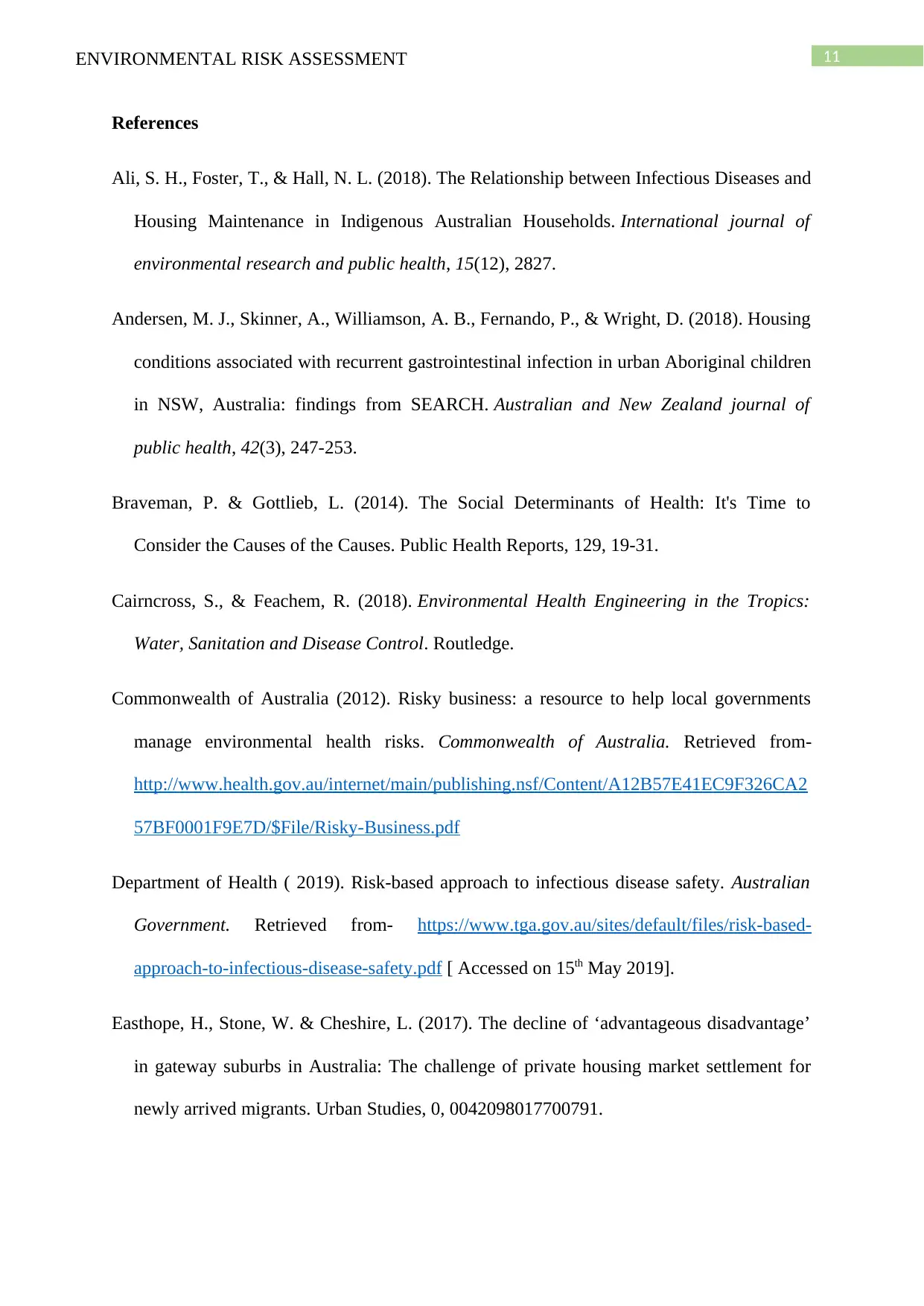
11ENVIRONMENTAL RISK ASSESSMENT
References
Ali, S. H., Foster, T., & Hall, N. L. (2018). The Relationship between Infectious Diseases and
Housing Maintenance in Indigenous Australian Households. International journal of
environmental research and public health, 15(12), 2827.
Andersen, M. J., Skinner, A., Williamson, A. B., Fernando, P., & Wright, D. (2018). Housing
conditions associated with recurrent gastrointestinal infection in urban Aboriginal children
in NSW, Australia: findings from SEARCH. Australian and New Zealand journal of
public health, 42(3), 247-253.
Braveman, P. & Gottlieb, L. (2014). The Social Determinants of Health: It's Time to
Consider the Causes of the Causes. Public Health Reports, 129, 19-31.
Cairncross, S., & Feachem, R. (2018). Environmental Health Engineering in the Tropics:
Water, Sanitation and Disease Control. Routledge.
Commonwealth of Australia (2012). Risky business: a resource to help local governments
manage environmental health risks. Commonwealth of Australia. Retrieved from-
http://www.health.gov.au/internet/main/publishing.nsf/Content/A12B57E41EC9F326CA2
57BF0001F9E7D/$File/Risky-Business.pdf
Department of Health ( 2019). Risk-based approach to infectious disease safety. Australian
Government. Retrieved from- https://www.tga.gov.au/sites/default/files/risk-based-
approach-to-infectious-disease-safety.pdf [ Accessed on 15th May 2019].
Easthope, H., Stone, W. & Cheshire, L. (2017). The decline of ‘advantageous disadvantage’
in gateway suburbs in Australia: The challenge of private housing market settlement for
newly arrived migrants. Urban Studies, 0, 0042098017700791.
References
Ali, S. H., Foster, T., & Hall, N. L. (2018). The Relationship between Infectious Diseases and
Housing Maintenance in Indigenous Australian Households. International journal of
environmental research and public health, 15(12), 2827.
Andersen, M. J., Skinner, A., Williamson, A. B., Fernando, P., & Wright, D. (2018). Housing
conditions associated with recurrent gastrointestinal infection in urban Aboriginal children
in NSW, Australia: findings from SEARCH. Australian and New Zealand journal of
public health, 42(3), 247-253.
Braveman, P. & Gottlieb, L. (2014). The Social Determinants of Health: It's Time to
Consider the Causes of the Causes. Public Health Reports, 129, 19-31.
Cairncross, S., & Feachem, R. (2018). Environmental Health Engineering in the Tropics:
Water, Sanitation and Disease Control. Routledge.
Commonwealth of Australia (2012). Risky business: a resource to help local governments
manage environmental health risks. Commonwealth of Australia. Retrieved from-
http://www.health.gov.au/internet/main/publishing.nsf/Content/A12B57E41EC9F326CA2
57BF0001F9E7D/$File/Risky-Business.pdf
Department of Health ( 2019). Risk-based approach to infectious disease safety. Australian
Government. Retrieved from- https://www.tga.gov.au/sites/default/files/risk-based-
approach-to-infectious-disease-safety.pdf [ Accessed on 15th May 2019].
Easthope, H., Stone, W. & Cheshire, L. (2017). The decline of ‘advantageous disadvantage’
in gateway suburbs in Australia: The challenge of private housing market settlement for
newly arrived migrants. Urban Studies, 0, 0042098017700791.
⊘ This is a preview!⊘
Do you want full access?
Subscribe today to unlock all pages.

Trusted by 1+ million students worldwide
1 out of 14
Related Documents
Your All-in-One AI-Powered Toolkit for Academic Success.
+13062052269
info@desklib.com
Available 24*7 on WhatsApp / Email
![[object Object]](/_next/static/media/star-bottom.7253800d.svg)
Unlock your academic potential
Copyright © 2020–2025 A2Z Services. All Rights Reserved. Developed and managed by ZUCOL.





